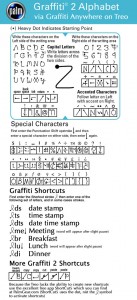 Yesterday’s unveiling of the Apple tablet, which we now know is called the iPad, showed a device with a larger surface than the iPhone / iPod Touch. It allows for a better reading and video experience and provides improved ways to do things like manage emails and photographs. Largely unaddressed with this release is a far more important question: How will this multi-touch make me better at thinking and creating?
Yesterday’s unveiling of the Apple tablet, which we now know is called the iPad, showed a device with a larger surface than the iPhone / iPod Touch. It allows for a better reading and video experience and provides improved ways to do things like manage emails and photographs. Largely unaddressed with this release is a far more important question: How will this multi-touch make me better at thinking and creating?
Rocking the PDA old skool with Palm’s Graffiti
Return with me for a moment to a simpler time, before smartphones got “smart.”
It was a time when the handheld device du jour was a Personal Digital Assistant (PDA). In the 1990’s, Palm released their Pilot PDA. These Treos, sans cell phone required a stylus for text entry. There was no QWERTY keyboard, and not even a cell phone number pad.
 The user needed to learn a type of stylus script called Graffiti to get text into the thing. Some people got good enough to write with something close to the speed of traditional longhand. Personally, as a lefty, I found it more comfortable to use Graffiti than to write in longhand. I didn’t have to think about the angle of the paper in relation to my contorted left hand. Smearing ink wasn’t an issue.
The user needed to learn a type of stylus script called Graffiti to get text into the thing. Some people got good enough to write with something close to the speed of traditional longhand. Personally, as a lefty, I found it more comfortable to use Graffiti than to write in longhand. I didn’t have to think about the angle of the paper in relation to my contorted left hand. Smearing ink wasn’t an issue.
This was many people’s introduction to a computer user interface beyond the keyboard. There was a lot wrong with it, though. Styluses are a pain to use. And many Palm users found Graffiti so difficult to use that they simply called up a hunt-and-peck keyboard. Here’s a YouTube demo of it in use.
For me the golden promise of multi-touch monitors is not the ability to flick through photo galleries or zoom into a map — as cool as those functions are. Ever since the first mass market multi-touch keyboard was made available with the invention of the iPhone, I was waiting for a faster way to record thoughts.
I was hoping yesterday to learn of a gestural script — a Graffiti without the stylus.
What’s so wrong with QWERTY keyboards?
Whether displayed on an iPhone, an iPod Touch, or now the iPad — old-fashioned keyboards simply don’t free the user to quickly jot something down and get back to work.
Instead, these devices force users to leave the fluid, intuitive work of (let’s face it!) grown-up finger painting. The appearance of the QWERTY keyboard sends them marching back indoors like a recess bell. Ugh! The taps of fingers on keys — even ultra-modern keys, projected on slick glass iPad surface — still evoke the drudgery of an oppressive cubicle farm.
I know this sounds a little glib, but think about it. Our speed of productive output are in many ways limited by our office supplies. Give someone a soul-crushing keyboard to think with and you’ll be producing something constrained by that medium. If their work soars, it’s in spite of the keyboard, not aided by it. In 2003, Jeff Han demonstrated to cheers the full effect of a multi-touch experience. I predicted then that this technology will quickly change the very nature of our work experience.
Apple knows this.
There have been accounts of Apple applying for and receiving patents on what would be the building blocks of a new gestural interface. New Scientist recently recounted the patents Apple has applied for to tap into “touch or hover” and “gesture dictionary.” That day may arrive with a new version of the iPad. It cannot come soon enough.
Related post:
Jeff Han’s demonstration of multi-touch screens
